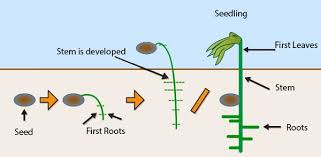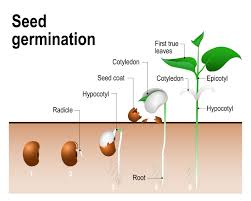The activation of the metabolic machinery of the seed embryo is the first and foremost step to initiate the seed germination process. Thus, seed germination is the process of reactivation of the metabolic activity of the seed embryo, resulting in the emergence of the radicle (root) and plumule (shoot), thus leading to the production of a seedling or a young plant.
Seed germination is a very complex process as it involves many biochemical, physiological, and morphological changes within a seed. For germination to be initiated, three conditions must be fulfilled:
- The seed must be viable, i.e., the embryo should be alive and capable of germination.
- The seed should be non-dormant, i.e., there should not be any dormancy or chemical barrier for germination.
- The environmental conditions like moisture, temperature, air (O₂), and light must be available in appropriate amounts.
If all these conditions are fulfilled, the quiescent embryo in the seed will resume growth, thus initiating the process of germination. In the early stages of growth, the embryo draws nutrients from the stored food material in the cotyledons or the endosperm. Later, new shoots/leaves are developed, which produce their own photosynthetic system.
Read Also: Bird of Paradise Flower (Strelitzia reginae): All You Need To Know About
Key Stages of Seed Germination In Plants

The process of seed germination involves several consecutive but overlapping events:
- Absorption of water,
- Initiation of cell enlargement and division,
- Increased enzymatic activity,
- Food translocation to the growing embryo,
- Increase in respiration and assimilation,
- Increase in cell division and enlargement, and
- Differentiation of cells into tissues and organs of a seedling.
The sequence of these events is not specific, and one event may overlap with another. However, the entire process of germination can be divided into the following stages:
1. Activation or Awakening Stage
i. Water Absorption: Early seed germination begins with the imbibition of water by the seed. Water is absorbed by the processes of imbibition and osmosis by the dry seeds, which softens the seed coat and other coverings and causes hydration of the protoplasm.
After imbibition of water, the seed swells, and seed coverings rupture, helping the protoplasm resume metabolic activity with the activation of enzymes.
During the hydration phase, the seed coat acts as a limiting factor, and its rupture increases water uptake. Water enters the seed through the micropylar pore and hilum. In general, water absorption is very rapid initially but slows down gradually.
ii. Synthesis and Activation of Enzymes: After hydration, enzyme activity begins quickly. Activation of enzymes is partly from the reactivation of stored enzymes and partly by the synthesis of new enzymes during the germination initiation process.
The hydrolytic enzymes convert complex food material into simpler forms, which can be readily translocated and absorbed by the embryo. The oxidative enzymes are involved in respiration and releasing energy for cell division and growth.
iii. Cell Elongation: Hydration, synthesis, and activation of enzymes help in cell elongation, resulting in the emergence of the radicle. The emergence of the radicle is the first visible symptom of germination, resulting from cell elongation rather than cell division.
Under favorable conditions, the emergence of the radicle may take place within a few hours in non-dormant seeds or a few days after sowing. The emergence of the radicle is considered the end of Stage 1, i.e., the activation or awakening stage.
2. Translocation Stage
Food materials like fats, carbohydrates, or proteins are stored in the endosperm or cotyledons. These compounds are converted into simpler forms and translocated to the growing points of the embryo. The process of conversion differs depending on the type of stored food material. For example:
i. Fats and oils are enzymatically converted first to fatty acids and then to sugars.
ii. Storage proteins are first converted to amino acids and then to nitrogen, essential for growing seedlings.
iii. Starch, present in many seeds as an energy source, is converted to simple sugars.
All these conversions are regulated by the metabolic activity of specific enzymes in a proper sequence.
3. Seedling Growth Stage
In this stage, the development of the seedling plant occurs through continued cell division in different growing points of the embryo, followed by the expansion of seedling structures. Cell division in the growing point and subsequent cell elongation are two independent processes in seedling development. As germination proceeds, the structure of the seedling soon becomes evident.
Types of Seed Germination in Crops

The radicle, the growing point of the root, emerges from the base of the embryonic axis, while the plumule, the growing point of the shoot, is at the upper end of the embryonic axis, above the cotyledons.
The section of the seedling stem above the cotyledons is called the epicotyl, and below the cotyledons is called the hypocotyl.
Two types of germination are commonly found in cultivated plants:
1. Epigeal Germination: Seed germination in dicots in which the cotyledons emerge above the soil surface. In this type, the hypocotyl elongates and raises the cotyledons above the ground, known as epigeous or epigeal germination. This type is common in beans, gourds, castor, tamarind, and onion.
2. Hypogeal Germination: Seed germination in dicots in which the cotyledons remain below the soil surface. In this type, the epicotyl elongates, and the hypocotyl does not raise the cotyledons above ground, known as hypogeous or hypogeal germination. This type is common in mango, custard apple, pea, gram, lotus, and maize.
Mobilization of Energy and Food Reserves During Germination
The absorption of water by the seed “turns on” and/or accelerates metabolic processes that lead to the resumption of active growth of the embryonic axis and support early seedling development. One of the basic processes accelerated is respiration.
Energy is required for the resumption of active growth of the embryonic axis—for germination and many supporting processes. This energy is provided by respiration. An air-dry seed at 10–13% moisture content respires at a very low rate.
During the water absorption phase of germination, the rate of respiration increases dramatically. Some of the energy released during respiration is in the form of heat, but most is converted from chemical forms to others.
The process of respiration requires a readily available substrate an organic compound that can be oxidized to release energy. The basic respiratory substrate is glucose, a simple sugar. During respiration, glucose is oxidized through complex processes into carbon dioxide and water, releasing substantial energy.
Since photosynthesis is not re-established until after germination is complete, the germination process depends on reserve organic compounds stored in the seed. Some of these compounds are in the embryonic axis in readily usable forms (e.g., sucrose) and serve as respiratory substrates for early germination.
The bulk of reserve materials, however, are stored as complex, non-mobile forms in specialized tissues. These must be broken down into simpler, translocatable forms to support germination.
Read Also: General Management Considerations in Livestock Management
Major Reserve Materials in Seeds

1. Starch and Complex Carbohydrates
i. Starch is the principal reserve in cereals and grasses, stored in the endosperm.
ii. During germination, gibberellin (a hormone) stimulates hydrolytic enzymes that break down starch into glucose, which is then converted to sucrose for translocation.
2. Fats and Oils (Lipids)
i. The most common reserve in many plant species due to their high energy value.
ii. Broken down enzymatically into fatty acids and glycerol, which are further metabolized for energy or new material synthesis.
3. Proteins
i. Broken down into amino acids, which are used for enzyme synthesis, new plant material, or energy production.
As the seedling develops, photosynthesis resumes, making it independent of seed reserves. Humans cultivate many plant species for these stored reserves, such as wheat for flour, rice for direct consumption, and oilseeds for fats.
In this article, seed germination, its types, and influencing factors were discussed. The process of seed germination, including the mobilization of energy and food reserves, was explained in detail.
Germination begins with water uptake by a quiescent dry seed and ends with the elongation of the embryonic axis. Water absorption follows three phases:
i. Phase I: Rapid initial uptake.
ii. Phase II: Plateau phase.
iii. Phase III: Further increase only if germination occurs.
The first signs of germination include the resumption of transcription, translation, DNA repair, cell elongation, and eventually cell division. Physically, germination occurs in two stages: testa rupture followed by endosperm rupture. Once the radicle emerges through the micropylar endosperm, germination is complete.
Do you have any questions, suggestions, or contributions? If so, please feel free to use the comment box below to share your thoughts. We also encourage you to kindly share this information with others who might benefit from it. Since we can’t reach everyone at once, we truly appreciate your help in spreading the word. Thank you so much for your support and for sharing!

